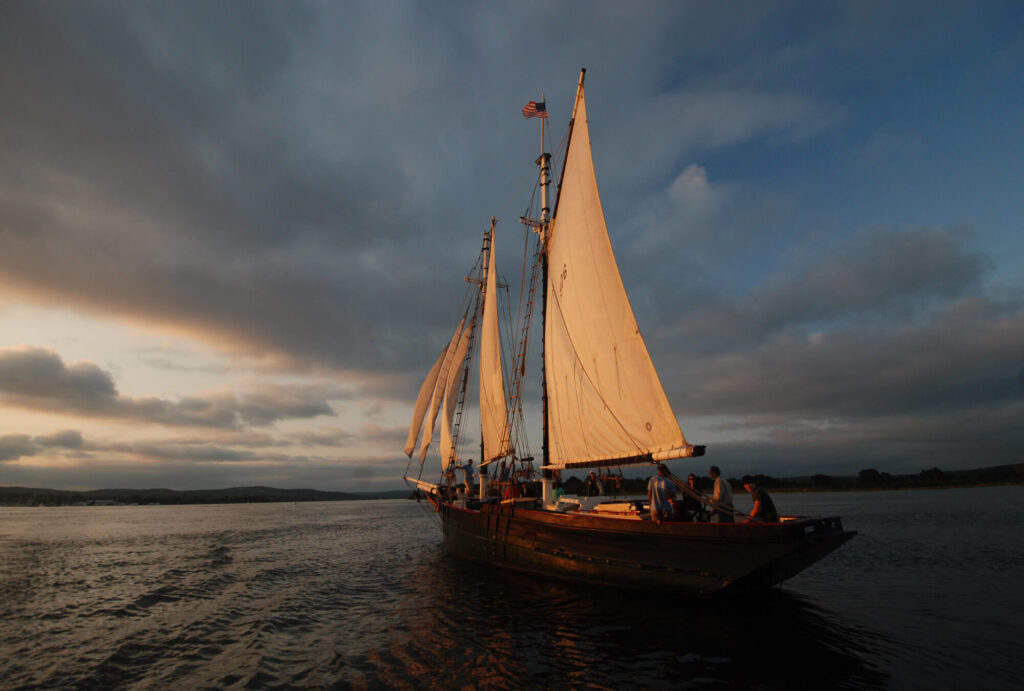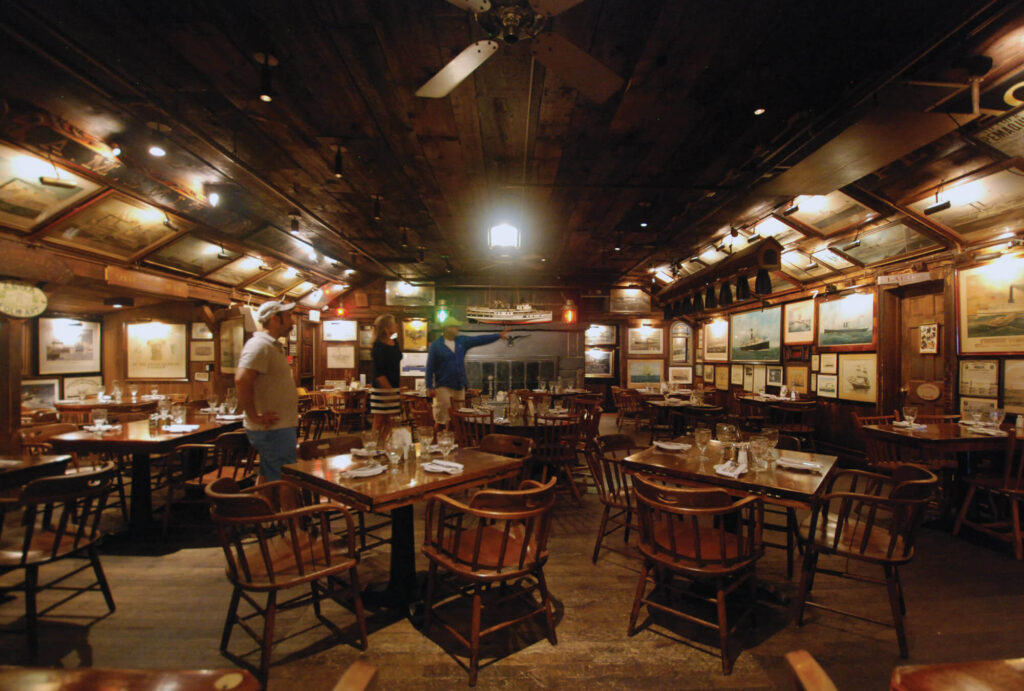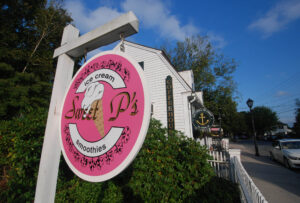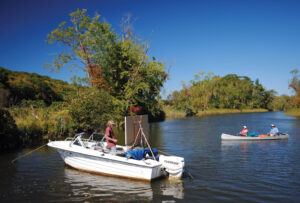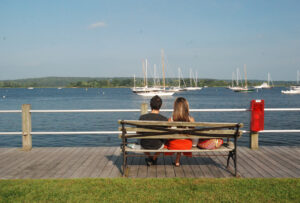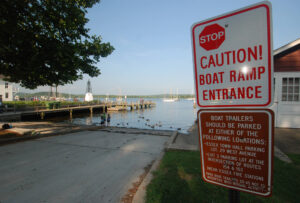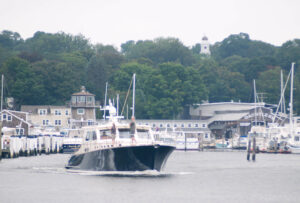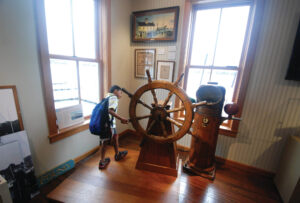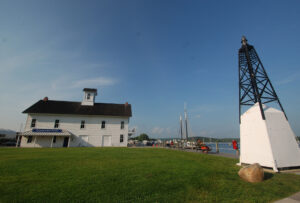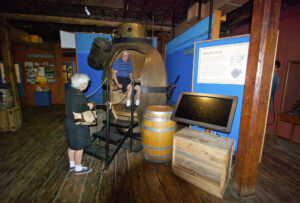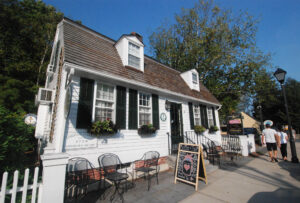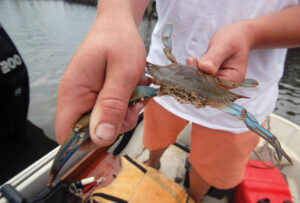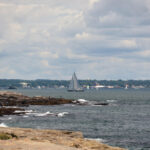
Jamestown Story
April 12, 2024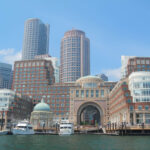
Boston Harbor Story
May 6, 2024
Welcome to Essex
With more than 300 years of maritime history to recommend it, this appealing village on the lower Connecticut River offers a bit of everything for visiting boaters.
ESSEX'S STORY
Tree swallows have seemingly stolen the show from bald eagles on the lower Connecticut River. Nearly every evening, from the end of August until mid-October, the migrating birds gather by the thousands to create a whirling, swirling aerial ballet in the sky before settling down to roost in the reeds along the river. The annual event is so spectacular it even prompted celebrated ornithologist Roger Tory Peterson to enthuse, “I have seen a million flamingos on the lakes of East Africa and as many seabirds on the cliffs of the Alaska Pribilofs, but for sheer drama, the tornadoes of tree swallows eclipsed any other avian spectacle I have ever seen.”
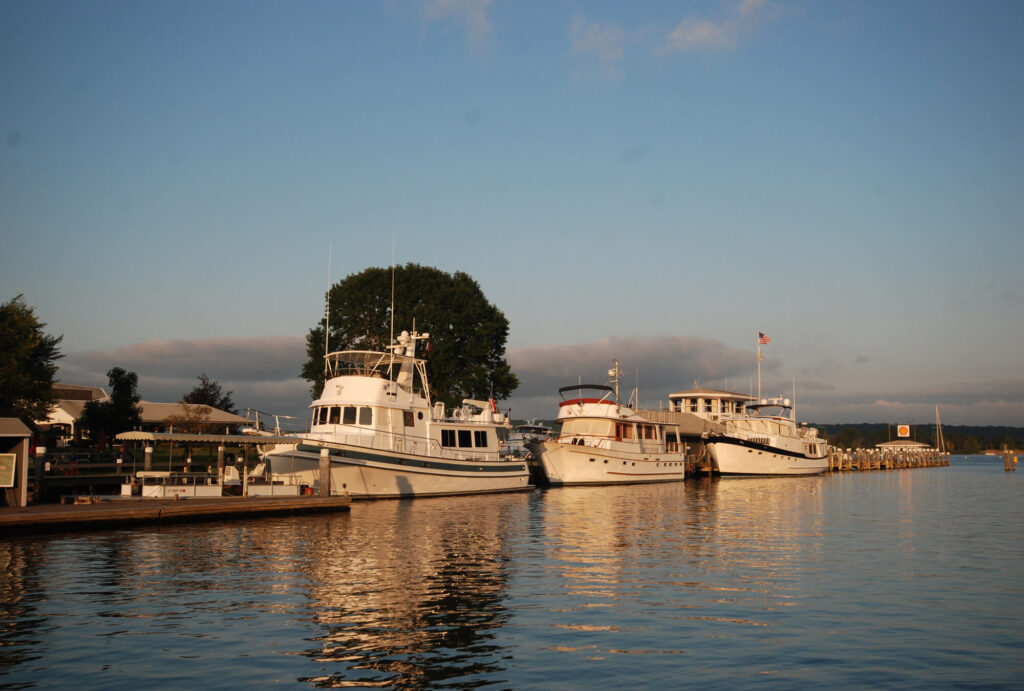
Safe Harbor Essex Island Marina is a favorite stop among transient boaters heading up or down the coast.
The evening swallow show is just one of the many wonders in store for boaters who choose to call on the town of Essex, some five miles from Long Island Sound. Mind, Essex is not some gussied-up tourist trap.
It draws visitors for what it is naturally—a picturesque and enduringly historic town that happens to have a soft spot for boaters. Indeed, the town likes to boast that there are more boat slips in Essex than parking spaces, and most of the shops and restaurants cater to a casually dressed, boat-shoe-clad clientele.
MARITIME PAST
Essex Village, framed by Middle Cove to the south (home of the Corinthian and Essex yacht clubs) and North Cove (where Safe Harbor Dauntless Shipyard Marina, Safe Harbor Essex Island Marina, and Essex Boat Works are found), has deep and important ties to America’s maritime history. Due to its proximity to Long Island Sound and the watery highway from the forested interior, Essex (originally called “Potapoug”) was a cinch to become a shipbuilding hub in the late 1700s. The first battleship ever built in North America, the Oliver Cromwell, was designed and launched here in 1776. The first working submarine, the American Turtle—a human-powered, barrel-shaped submersible designed to blow up British ships at anchor—was also conceived and constructed nearby.
Yet this naval innovation did not always work in the village’s favor. During the War of 1812, the local shipbuilding activity attracted the attention of the British, who attacked Essex and burned several newly constructed ships in 1814. Each May, Essex commemorates the “burning of the ships” with a fife-and-drum parade along Main Street.
When the United States began to establish international trade routes, Essex became a major stop for ships on the New York-to-Boston packet route. The building that now houses the excellent Connecticut River Museum originally served as a warehouse for exotic cargo brought to Essex via steamships in the late 1800s. Elephant tusks from Zanzibar (to supply the ivory cutting facilities in nearby Ivoryton), sugar cane from the Caribbean, tobacco from the South and tons of coal were offloaded and stored here.
Today, the restored building holds a treasure trove of significant artifacts, including a trunk from the Oliver Cromwell, its lid bearing the symbol of the new republic—a bald eagle, a bird that can once again be spotted along the river. Oil paintings, murals, half-hull models, and a rare navigational chart from the 1700s adorn the walls of the museum. Visitors can even climb inside a full-scale replica of the American Turtle to experience plucky Yankee ingenuity firsthand. The museum is a must-visit for boaters and history buffs alike.
GOOD TIMES AT THE GRIS
For more maritime history and art, cross the street to the oldest continuously operating inn in the United States. The Griswold Inn—known to locals simply as “the Gris”—has been owned by just six families since it opened in June 1776. The inn contains the largest private maritime art collection in the country, most of it amassed by the prior owners from the 1890s to the 1990s. The cozy, wood-paneled interior of the inn’s restaurant, which resembles the saloon of a ship, is adorned with paintings and prints that chronicle Connecticut Valley history and the steamboat era. Complimentary hour-long tours, heavy on exciting stories, run select Sundays in late fall, winter, and early spring. They begin at 5:00 p.m. in the wine bar with tastings.
Of course, you can also dine or simply enjoy drinks at the Gris, whose chef specializes in traditional New England cuisine, including aged steaks, chops, seafood, prime rib, and poultry. Lighter fare, appetizers, sandwiches, and an assortment of microbrews can be enjoyed in the celebrated Tap Room, which features live music nearly every night. Esquire Magazine has listed the place among the Best Bars in America and New York Magazine has mentioned it several times, and referred to the Tap Room as, quite possibly, the “best-looking drinking room
VILLAGE EATS
Another popular gathering spot among visiting boaters and locals is the Black Seal, just down the road from the Gris. The lively restaurant and bar specializes in creative burgers and salads in a space filled with nautical charts, and memorabilia.
You’ll encounter even more boaters if you opt for breakfast, lunch or dinner at Siren, the restaurant at Safe Harbor Essex Island Marina, accessible via a free, one-minute ferry ride from the mainland, and also is a great dock-and-dine option for Connecticut River boaters, space permitting.
The village is also loaded with shops and boutiques, including the Essex Coffee and Tea Company and Olive Oyl’s, where you can load up on trendy provisions and creative carry-out cuisine for the boat. Other noteworthy stores along Main Street include Toys Ahoy, J. Alden Clothiers, and Cortland Park.
RIVER REWARDS
While the shoreside delights of Essex can occupy you for hours, if not days, the river demands attention. For a simple side trip, take a small boat, dinghy, or kayak to Nott Island, where you’ll find sandy beaches that are ideal for a family picnic. Or head upriver a few miles to Selden Island State Park, where you can go ashore and explore the wooded interior and the remains of an old quarry. Hand-lining for blue crabs—a popular late-summer pastime—can be enjoyed from the town landing and Steamboat Wharf, or you can pursue striped bass, bluefish, and flounder closer to the river mouth.
If you’d like someone else to take the helm while you sit back and enjoy the river, there are several options. Grab a spot on the 75-foot, 1906 gaff-rigged schooner Mary E, based at the Connecticut River Museum’s Steamboat Dock, for a 1 1/2-hour excursion or two-hour sunset sail. Or combine a trip on the 65-foot, 45-ton paddlewheeler Becky Thatcher with a ride in a 1930s-era Pullman car on the Essex Steam Train. This authentic working steam train departs from Essex and runs north to Deep River, where passengers can board the Thatcher. The riverboat chugs upriver to East Haddam and the Goodspeed Opera House before returning to the landing and train station.
Another river-tour option, especially for those who want to view the murmurations of tree swallows in fall and the soaring bald eagles in winter and spring, is the eco-tour boat RiverQuest, berthed in the shadow of the East Haddam Swing Bridge, 10 miles upriver from Essex. On Eagle Cruises, guests are likely to see at least one bald eagle patrolling the river or feeding its young. RiverQuest provides entertaining, annotated trips aboard the 54-foot, 50-person vessel, with a mission to educate groups about the history, ecology, and use of Connecticut’s longest and most celebrated river.
Whether you come for the history, the food, the boating amenities or the natural wonders, a trip to Essex belongs on your itinerary this season. No matter what your background, you’re sure to make a connection.
ESSEX GALLERY
Written by Malerie Yolen-Cohen
Malerie is the Author of the cross-country travel guide, Stay On Route 6; Your Guide to All 3562 Miles of Transcontinental Route 6. You can also travel the country with her at Getaway Mavens. She contributes frequently to Newsday, with credits in National Geographic Traveler, Ladies Home Journal, Yankee Magazine, Shape.com, Sierra Magazine, Porthole, Paddler, New England Boating Magazine, and dozens of other publications.
Photographed by Tom Richardson
A Massachusetts native and past editor of New England Boating & Fishing, Tom has spent time working for Salt Water Sportsman, Offshore Magazine and was a founder of BoatingLocal. You can now find Tom as the Host, Executive Producer at Explore New England TV.
REGIONAL NEWS
I am text block. Click edit button to change this text. Lorem ipsum dolor sit amet, consectetur adipiscing elit. Ut elit tellus, luctus nec ullamcorper mattis, pulvinar dapibus leo.


